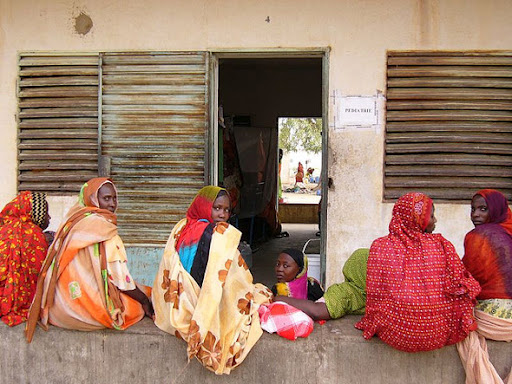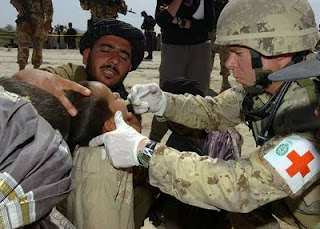-
Human Resources for Maternal Health
› “Pregnancy is not a disease, a woman should not die of pregnancy…it doesn’t need a new drug…it doesn’t need research – we just need skilled workforce at different levels,” argued Seble Frehywot, assistant research professor of Health Policy and Global Health at George Washington University, at the Global Health Initiative’s second event of the Advancing Policy Dialogue on Maternal Health Series.
“Pregnancy is not a disease, a woman should not die of pregnancy…it doesn’t need a new drug…it doesn’t need research – we just need skilled workforce at different levels,” argued Seble Frehywot, assistant research professor of Health Policy and Global Health at George Washington University, at the Global Health Initiative’s second event of the Advancing Policy Dialogue on Maternal Health Series.
Research shows that increased access to skilled health workers during pregnancy and delivery, including midwives and other practitioners, can significantly reduce maternal mortality in developing countries. One solution to the current human resource crisis is to expand, and in many cases, acknowledge, the skills and responsibilities of non-physician health workers.
Task-Sharing: Who, What, and How
“There are too many preventable deaths…if we look at the data, quality maternal health services are not available,” argued Frehywot, as she presented the following evidence:
There are four common types, or levels, of task-shifting:- Countries that have the highest maternal mortality rates are those that also have the greatest worker shortage
- In Africa, for every 10,000 births, only 2 physicians and 11 nurses or midwives are present at delivery.
- According to the World Health Organization, there needs to be at least 53 skilled health care workers (nurses, doctors, midwives) per 10,000 births to meet Millennium Goal 5 which seeks to reduce maternal deaths by 75 percent by 2015.
1. Doctors to non-physician health clinicians
“All [task-shifting] needs to be done through a sound regulatory framework…it is very important to match tasks that are needed at the ground level with the competency needed to back it up,” maintained Frehywot. Regulatory issues such as the scope of practice, standard of care, training, licensure, and supervision must be addressed to ensure safe and high-quality treatment. Additionally, political buy-in and commitment from the Ministry of Health, medical universities, and professional councils and associations are necessary for long-term development, argued Frehywot.
2. Health clinicians to registered nurses and midwives
3. Nurses/midwives to community health care workers
4. Community health care workers to expert patients
Policies for scaling-up human resources should start at the district level, as these localized hospitals are geographically closest to the need, argued Frehywot. “If one really wants to decrease the maternal mortality ratios, especially by 2015, this is where most of the people live.”
Applying Task-Shifting in Afghanistan “Maternal mortality ratios in Afghanistan are the second highest in the world,” declared Jeffrey Smith, regional technical director for Asia at Jhpiego. In 2002, when Smith arrived in Afghanistan, there were limited health workers, most with out-of-date skills, and no functional schools for training. “The most important decision made early in the reconstruction [of] Afghanistan was that midwives would be the backbone of the reproductive health workforce and they would be empowered with the skills to perform the tasks necessary for provision of basic emergency obstetric care,” shared Smith.
“Maternal mortality ratios in Afghanistan are the second highest in the world,” declared Jeffrey Smith, regional technical director for Asia at Jhpiego. In 2002, when Smith arrived in Afghanistan, there were limited health workers, most with out-of-date skills, and no functional schools for training. “The most important decision made early in the reconstruction [of] Afghanistan was that midwives would be the backbone of the reproductive health workforce and they would be empowered with the skills to perform the tasks necessary for provision of basic emergency obstetric care,” shared Smith.
Making the case for task-shifting, Smith discussed the importance of empowering health workers on the front line so that they may provide services in the most peripheral areas. “Task shifting should not be a temporary fix until we have more doctors,” argued Smith, as this framework disenfranchises a cadre of health workers and fails to build long-term solutions for human resources. Instead, Smith advocated for the “Health Center Intrapartum Care Strategy” that makes midwives the foundation of care and includes strategies for training, staffing, and linkages to the overall health system.
In this post-conflict setting, task-shifting began as an emergency approach. However, it rapidly became a development strategy for professionalizing the workforce and rebuilding the health system. Afghanistan’s Ministry of Public Health was imperative to the success of scaling up midwives as they clearly defined from the beginning what was needed and who would provide care, taking steps to ensure that the midwifery schools maintained legitimacy and received formal accreditation.
“Keep it clinical and keep it local,” shared Smith. The midwifery schools made efforts to recruit individuals from the provincial level, teaching specific life-saving skills applicable in the field. This framework has successfully retained 86% of its graduates, and many of the women report that the program has provided them with a sense of community and ownership.
Building a Sustainable Health Workforce “We invite the maternal health community to take advantage of the incredible momentum that human resources for health is having right now,” shared Pape Gaye, president and CEO of IntraHealth. While there are many issues within the health system that need to be strengthened, Gaye maintained that “we must pick our battles” and advocated for an emphasis on scaling-up the training and availability of midwives.
“We invite the maternal health community to take advantage of the incredible momentum that human resources for health is having right now,” shared Pape Gaye, president and CEO of IntraHealth. While there are many issues within the health system that need to be strengthened, Gaye maintained that “we must pick our battles” and advocated for an emphasis on scaling-up the training and availability of midwives.
In order to scale-up midwives for maternal health we must avoid the same old traps, particularly the lack of donor coordination shared Gaye. “If we do a better job of improving coordination we will start solving the problem.” Additionally, Gaye discussed the implications for training generation “Y,” emphasizing the importance of including new technologies available for training, including PDA’s and e-learning courses.
Performance outcomes and training are the two key pillars of effective scale-up, shared Gaye. Task-shifting also requires legal support and the endorsement from medical associations to help legitimize this new health system framework. “This is not simple work; you really need to have a systems approach. What we seek in the end is good integration. Integration across systems, integration across roles, courses, learning processes, and training for maximum adaptability,” shared Gaye. -
Integrating HIV/AIDS and Maternal Health Services
›
Integrating maternal health and HIV/AIDS services “includes organizing and providing services that meet several needs simultaneously…focusing not only on the condition, but also the individual,” argued Dr. Claudes Kamenga, Senior Director of Technical Support and Research Utilization at Family Health International, during the first event of the Advancing Policy Dialogue on Maternal Health series co-convened by the Wilson Center’s Global Health Initiative, Maternal Health Task Force (MHTF), United Nations Population Fund (UNFPA), and technical support from U.S. Agency for International Development (USAID). Joined by Michele Moloney-Kitts, assistant coordinator at the Office of the U.S. Global AIDS Coordinator, and Harriet Birungi, a program associate with the Population Council in Kenya, the panelists discussed how integration of HIV/AIDS and maternal health services not only improves health outcomes, but also increases program efficiencies, strengthens health systems, and saves money.
-
Tackling the Biggest Maternal Killer: How the Prevention of Postpartum Hemorrhage Initiative Strengthened Efforts Around the World
›On Friday, November 20th, 120 representatives from the maternal health community, the U.S. and around the world, gathered for an all day meeting at the Woodrow Wilson International Center for Scholars to discuss the report, Tackling the Biggest Maternal Killer: How the Prevention of Postpartum Hemorrhage Initiative Strengthened Efforts Around the World. This report describes the challenges and successes of the U.S. Agency for International Development (USAID) funded Prevention of Postpartum Hemorrhage Initiative (POPPHI).
The five-year POPPHI project was executed through the support of many partners whose main goal was to catalyze the expansion of active management of the third stage of labor (AMTSL) worldwide. The conference convened experts and advocates in the field of maternal health, to share best practices, new innovations, and future challenges for tackling maternal health’s leading killer: postpartum hemorrhage (PPH). Panelists included POPPHI field partners such as International Federation of Gynecology and Obstetrics, The International Confederation of Midwives, the World Health Organization, and international researchers.
Preventing Postpartum Hemorrhage: AMTSL
“We need to work on women postpartum–after birth we leave them,” argued Deborah Armbruster, POPPHI Project Director. Due to the fact that many women in the developing world give birth at home or in local clinics that lack the sufficient resources to prevent postpartum hemorrhaging, approximately 132,000 women die annually. Fortunately, effective and feasible interventions such as those established by POPPHI have been proven to save lives.
Active management of the third stage of labor (AMTSL) includes three factors that, when used together, can avert postpartum hemorrhage, including:1. Administration of uterotonic drugs (including oxytocin – the most preferred drug)
POPPHI’s “BOLD” Approach
2. Controlled cord contraction
3. Uterine massage after the delivery of the placenta
In collaboration with its partners, POPPHI implemented country-level and global programs to scale up AMTSL. Driven by the “BOLD” approach, Armbruster described how the initiative provided overall frameworks and approaches for strengthening PPH interventions by Building on evidence, Obtaining consensus, Linking partners, and Demonstrating to policymakers AMTSL’s feasibility.
Additionally, POPPHI provided learning materials such as toolkits, fact sheets, posters, and guides that were used to train providers and increase their use of AMTSL. A pilot project on Uniject (a single use needle pre-prepared with oxytocin) was also executed in Mali. Uniject was shown to be acceptable and successful with birth attendants there, and the study is now being replicated in Honduras.
Voices from the Field
Representatives from Argentina, Bangladesh, Ghana, Guatemala, Peru, and Mali presented their country results with the POPPHI project–concluding that the initiative served as a catalyst for upscaling AMTSL. Dr. Abu Jamil Faisel, Project Director and Country Representative of EngenderHealth in Bangladesh, discussed how the project helped to break through misperceptions that often prevented women from wanting to use misoprostol. In Ghana, policymakers worked with program managers and drug suppliers to register misoprostol in the country’s essential medicine list and updated guidelines to reflect best practices. While each country’s experiences were unique, the importance of partnerships was common to successfully upscaling AMTSL in all locations.
Partnerships: Critical to Success
Integrating maternal health indicators directly into program design is imperative to upscaling AMTSL, argued Niamh Darcy, Director of POPPHI Monitor and Evaluation. Additionally, Darcy argued that the success of POPPHI is due to the project’s emphasis in working with all levels of partners, particularly facility providers. Working with the supportive supervisors at facilities is necessary according to Darcy because this group is ultimately responsible for executing active management and recording project outcomes.
Identifying African experts who have taken leadership and ownership of the project has been instrumental in POPPHI successfully disseminating results at the regional, national and international levels argued Doyin Oluwole, Director, Africa’s Health in 2010. Partnering with local champions as well as policymakers has enabled many of the country projects to build capacity and upscale AMTSL.
Building on Lessons Learned
“A key lesson we have learned is that, when there is political commitment, AMTSL is rapidly scalable,” stated Lily Kak, Senior Maternal and Newborn Health Advisor, USAID. Changing behaviors and practices takes significant amount of resources and time commitment, however, POPPHI demonstrates that partnerships and research can be used to upscale AMTSL and change policies more efficiently.
Photo: Women wait outside a maternity ward in Chad. Courtesy of Flickr user mknobil. -
U.S. Policy on Post-Conflict Health Reconstruction
›December 8, 2009 // By Calyn Ostrowski Stabilizing and rebuilding state infrastructure in post-conflict settings has been increasingly recognized as critical to aiding the population and preventing renewed conflict. The United States has increasingly invested in rebuilding health systems, and in some cases assisting in the delivery of health services for the first time.
Stabilizing and rebuilding state infrastructure in post-conflict settings has been increasingly recognized as critical to aiding the population and preventing renewed conflict. The United States has increasingly invested in rebuilding health systems, and in some cases assisting in the delivery of health services for the first time.
While global health concerns have recently received significant attention, as witnessed by President Obama’s Global Health Initiative, the importance of health system reconstruction to stabilization efforts remains unevenly recognized. On November 10, 2009, experts met at the Global Health Council’s Humanitarian Health Caucus to discuss investing in health services in the wake of war and the challenges of funding this investment.
“Deconstruction from violence extends beyond the time of war and often leads to severe damage of health infrastructure, decreased health workers, food shortages, and diseases…resulting in increased morbidity and mortality from causes that are not directly related to combat,” shared Leonard Rubenstein, a visiting scholar at Johns Hopkins School of Public Health. Rubenstein argued that while relieving suffering in post-conflict settings should be a sufficient reason to include health reconstruction in U.S. foreign policy, policymakers narrowly define rationales for engagement based on claims that investments increase peace and improve the image of the U.S. government.
Investing in Health Systems Builds State Legitimacy
The evidence for investing in health systems to deter future conflict is limited and this approach is dangerous, according to Rubenstein, because it distorts spending decisions and fails to consider comprehensive capacity development strategies. Additionally, the Department of Defense’s approach of “winning the hearts and minds” is too short-term and neither linked to “system-building activities that are effective and sustainable…nor consistent with advancing the health of the population,” he said.
Instead, Rubenstein recommended that the United States invest in health systems after conflict because it advances state legitimacy. Although additional evidence is necessary, Rubenstein maintains that the promotion of state legitimacy enhances the perception that the government is responding to their long-term needs and encourages local ownership and accountability. Developing health systems in post-conflict settings is complex and cannot be done quickly, he noted, and thus increased financial and human resource capacities will be essential.
Coordination and Transition Funding
“We need to recognize that the U.S. is not the only funder, as there are many stakeholders involved,” argued Stephen Commins, strategy manager for fragile states at the International Medical Corps. Commins argued that there is a “desperate need to coordinate donor funding … both within and across government systems, as well as an increased need for transparent donor tracking systems.”
As countries come out of conflict and start to gain government legitimacy, they need increased support to stabilize conflict and avoid collapse. Transition funding for health systems needs to support both short and long-term efforts, maintained Commins, but unfortunately the donors driving these timelines are often driven by self-interest, not the rights of the individual living in conflict.
Without a transparent donor tracking system, it is hard to demonstrate actual monetary disbursements versus commitments, so Commins called for a system that tracks allocations and spending in real time. These are not our countries, he argued, and responding to health systems in post-conflict settings should be tailored to the country’s needs, not the donor’s. He also called for increased research that describes, over time, the costs for rebuilding and transitioning from international NGO-driven systems to self-sustained governments.
Rebuilding Health Systems in Sudan
George Kijana, health coordinator in southern Sudan for the International Rescue Committee, discussed reasons for why Sudan’s health system remains poor five years after conflict. According to Kijana, the government in Southern Sudan has not been held accountable by its donors, leading to a breakdown in infrastructure and a lower quality of health workers.
Additionally, a majority of the available health data comes from non-state actors that are not easily accessible. Kijana shared that in order for Sudan to move forward, more research and data are needed to help target long-term capacity building projects, as well as short-term interventions that address infant and maternal mortality. While progress is slow, he pointed out encouraging signs of progress, as the Ministry of Health now recognizes their weaknesses and positively engages with its development partners such as the United Nations.
Photo: Romanian Patrol administers medical treatment to Afghan communities, courtesy of Flickr user lafrancevi.
-
Start With A Girl: A New Agenda For Global Health
›November 16, 2009 // By Calyn OstrowskiThe Center for Global Development’s latest report, Start With A Girl: A New Agenda For Global Health, sheds light on the risks of ignoring the health of adolescent girls. Like other reports in the Girls Count series, it links broad social outcomes with adolescent health. “Adolescence is a critical juncture for girls. What happens to a girl’s health during adolescence determines her future–and that of her family, community, and country,” state coauthors Miriam Temin and Ruth Levine.
Between childhood and pregnancy, adolescent girls are largely ignored by the public health sector. At the same time, programs and policies aimed at youth do not necessarily meet the specific needs of girls. Understanding the social forces that shape girls’ lives is imperative to improving their health.
Like recent books by Michelle Goldberg and Nicholas Kristof, the report argues for increased investment in girls’ education to break down the social and economic barriers that prevent adolescent girls from reaching their full potential. Improving adolescent girls’ health will require addressing gender inequality, discrimination, poverty, and gender-based violence.
“For many girls in developing countries, well-being is compromised by poor education, violence, and abuse,” say Temin and Levin. “Girls must overcome a panoply of barriers, from restrictions of their movement to taboos about discussion of sexuality to lack of autonomy.” The report points to innovative government and NGO programs that have successfully changed negative social norms, such as female genital cutting and child marriage. However, the authors urge researchers to examine the cost-effectiveness and scalability of these programs.
In the last five years, the international community has become increasingly aware of the importance of youth to social and economic development. Some new programs are focused on investing in adolescent girls, such as the World Bank’s Adolescent Girls Initiative and the White House Council on Women and Girls, but significant additional investment and support is needed.
“Big changes for girls’ health require big actions by national governments supported by bilateral and multilateral donor partners, international NGOs…civil society and committed leaders in the private sector,” maintain Temin and Levin. They offer eight recommendations:
1. Implement a comprehensive health agenda for adolescent girls in at least three countries by working with countries that demonstrate national leadership on adolescent girls.
2. Eliminate marriage for girls younger than 18.
3. Place adolescent girls at the center of international and national action and investment on maternal health.
4. Focus HIV prevention on adolescent girls.
5. Make health-systems strengthening and monitoring work for girls.
6. Make secondary school completion a priority for adolescent girls.
7. Create an innovation fund for girls’ health.
8. Increase donor support for adolescent girls’ health.
“We estimate that a complete set of interventions, including health services and community and school-based efforts, would cost about $1 per day,” say the authors of Start With a Girl. There is no doubt in my mind that this small investment would indeed have a high return for the entire global community. -
Traffic Jam: Gender, Labor, Migration, and Trafficking in Dubai
›November 16, 2009 // By Calyn Ostrowski“All trafficking is not sex trafficking,” argued Woodrow Wilson Center Fellow Pardis Mahdavi, at a recent Middle East Program event. Drawing on her ethnographic research in the United Arab Emirates, Mahdavi analyzed the policy implications of the latest Trafficking in Persons (TIP) report by the United Nations Office on Drugs and Crime. The TIP report offers information on modern day slavery–human trafficking–and includes comprehensive data on policies and enforcement in 155 countries and territories.
The TIP report paradoxically hurts the people it tries to protect, claimed Mahdavi, by placing too much emphasis on sex trafficking and failing to take into consideration other types of abuse, such as those against men and migrant labor workers. Mahdavi pushed for a “breakthrough of the labeling and politicizing of sex traffickers as women and children,” which depicts women as passive and helpless, while excluding male victims.
According to Mahdavi, in Dubai, 80 percent of the population are migrant laborers. Often, these foreign workers do not trust the government to protect them against trafficking abuses, particularly if they are working in the host country illegally. Thus, civil society organizations, and not the state government, serve as the major source of protection and recourse for abused migrant workers. In the Persian Gulf region, Mahdavi argued that the “TIP report needs to be rewritten…to include increased labor inspectors and police training,” and called for the increased “accountability and transparency” of civil society organizations.
Mahdavi cautioned countries against using the TIP report to enact policies that make migration illegal. Tightening borders forces workers into the informal economy, she maintained, where it becomes difficult to track and protect these individuals.
Although the TIP report has weaknesses, it does pressure countries to act, as Mahdavi has witnessed in the United Arab Emirates, where it has provided opportunities for dialogue on the various aspects of trafficking. -
Cultural Conundrums: ‘State of World Population 2008’
›November 21, 2008 // By Calyn OstrowskiReleased at the National Press Club on November 12, 2008, the UN Population Fund’s State of World Population 2008 encourages policymakers and the development community to embrace culturally aware approaches to achieving human rights such as gender equality and reproductive health. Noting the role local culture plays in these issues, the report makes suggestions for addressing traditional attitudes toward maternal mortality, female genital mutilation, honor killings, and contraceptive use, highlighting the need to develop alliances with local opinion leaders in program design and service delivery.
U.S. Representative Carolyn Maloney (D-NY) urged both policymakers and development professionals to carry out development projects within the context of local cultural norms. According to Maloney, the Obama administration has promised to allocate funds to help implement the report’s recommendations. Azza Karam, senior culture advisor with UNFPA, explained that much development work still does not guarantee women’s rights and argued that State of World Population 2008 includes effective approaches to addressing harmful cultural practices. Karam encouraged the development community to approach culture pragmatically, demonstrating to local community leaders how changes in cultural practices benefit the whole community.
State of World Population 2008 devotes an entire chapter to the need to include women in post-conflict reconstruction, using case studies to demonstrate how gender equality can be incorporated into a variety of different peace interventions. The report pushes policymakers and program managers to endorse gender-sensitive approaches and abandon preconceptions that women lack the expertise to assist in long-term peacebuilding. Increasing women’s participation in post-conflict reconstruction “can help development practitioners mitigate some of the ill effects of conflict, minimize deterioration in gender relations and work with local communities and relevant stakeholders” to ensure women’s rights such as reproductive health and gender equality.
Showing posts by Calyn Ostrowski.


 “Pregnancy is not a disease, a woman should not die of pregnancy…it doesn’t need a new drug…it doesn’t need research – we just need skilled workforce at different levels,” argued Seble Frehywot,
“Pregnancy is not a disease, a woman should not die of pregnancy…it doesn’t need a new drug…it doesn’t need research – we just need skilled workforce at different levels,” argued Seble Frehywot,  “
“ “We invite the maternal health community to take advantage of the incredible momentum that human resources for health is having right now,” shared Pape Gaye, president and CEO of IntraHealth. While there are many issues within the health system that need to be strengthened, Gaye maintained that “we must pick our battles” and advocated for an emphasis on scaling-up the training and availability of midwives.
“We invite the maternal health community to take advantage of the incredible momentum that human resources for health is having right now,” shared Pape Gaye, president and CEO of IntraHealth. While there are many issues within the health system that need to be strengthened, Gaye maintained that “we must pick our battles” and advocated for an emphasis on scaling-up the training and availability of midwives.

 Stabilizing and rebuilding state infrastructure in post-conflict settings has been increasingly recognized as critical to aiding the population and preventing renewed conflict. The United States has increasingly invested in rebuilding health systems, and in some cases assisting in the delivery of health services for the first time.
Stabilizing and rebuilding state infrastructure in post-conflict settings has been increasingly recognized as critical to aiding the population and preventing renewed conflict. The United States has increasingly invested in rebuilding health systems, and in some cases assisting in the delivery of health services for the first time.

